Switch to the dark mode that's kinder on your eyes at night time.
Switch to the light mode that's kinder on your eyes at day time.

What are the Operating Sectors of Tourism Industry?
The tourism industry generates billions of dollars in revenue each year and employs tens of millions of people around the world. Tourism, whether it’s foreign or domestic, comes from many different sources, but the majority of tourists come from a handful of specific industries that provide much-needed help to economies everywhere. Knowing the different operating sectors of the tourism industry will help you better understand how to attract tourists to your region or country and benefit from their positive economic impact. Here are some tips on the different types of operating sectors in tourism.
Introduction:
Tourism is a major contributor to economies across nearly every continent. However, it’s more than just an industry; it’s an art form and a passion. In 2016, tourism supported one in ten jobs around the world, as well as two billion jobs indirectly. This support is valued at $7 trillion USD per year – three times larger than any other service industry. With such huge contributions to GDP, employment, and trade balance, you might think that everyone knows what makes up the tourism industry. But there are actually many different segments within tourism: leisure travel, business travel, international students studying abroad on J-1 visas, or working abroad on F-1 visas for example. Understanding these segments can help you identify which ones are most profitable for your own business. Here’s a breakdown of how each segment works, their biggest challenges, and some tips for success.
Hotels and lodging:
Hoteliers are in charge of hotels, motels, inns, and other lodging facilities. In most cases, they also oversee or own restaurants and bars on site. Some provide tourism information to guests; others offer travel packages that include airfare and hotel stays. Hoteliers work long hours and spend a lot of time on their feet, but they usually have a lot of autonomy in determining operating procedures within their business model. Their earnings depend largely on how many rooms they can fill. According to CareerBuilder, an average front-desk manager earns $31,200 per year.
Transportation:
Airlines, railways, ferries, and cruise ships are responsible for transporting people and goods to and from destinations. The tourism industry depends on transportation companies to move tourists around once they arrive at their destinations. If you’re looking to work in travel and hospitality, transportation is a good place to start your career. Airline attendants, train conductors and ferry workers all fall under transportation jobs in tourism. These workers are essential in ensuring that tourists have safe, comfortable journeys between destinations. They also ensure that passengers adhere to any special rules or regulations set by airlines or other transportation providers. Airline staff, for example, must ensure passengers meet certain age requirements before allowing them onto flights. They also must check each passenger’s identification to make sure he or she has valid tickets and proper documentation before allowing them onto planes. In addition to providing basic safety guidelines, many airline staff members must also be trained in first aid techniques as part of their job responsibilities.
Food service:
Restaurants and bars are a major part of food service, and most operate year-round. In fact, it’s one of the few sectors that have openings for seasonal employees. While there’s a lot to learn—from how to run front-of-house duties to how a kitchen works—the perks are excellent. You work in fun environments with great people, serving delicious food and drinks. You can get real experience in managing staff and finances while still earning good money.
Recreation and entertainment:
Recreation is one of the largest operating sectors in tourism, accounting for 14 percent of all tourism expenditures in 2012. Entertainment venues include theme parks, sports arenas, and convention centers. These venues attract customers with musical events, plays, and family-friendly attractions. The largest entertainment attraction is Disney World near Orlando, Florida. It hosted more than 20 million visitors in 2014, making it one of the most visited tourist destinations on Earth. Other popular recreation destinations include casinos, state fairs, and water parks. Many recreation facilities operate year-round to accommodate seasonal tourism spikes. For example, ski resorts remain open during the summer months to accommodate skiers and snowboarders who are looking for fun before school starts up again.
Do you like to know about Tourism Goals and Objectives
Community, social, personal services:
If you have a special talent, such as painting or playing music, you can make money by selling your wares to other tourists. Also, check with tour companies to see if they need guides for their tours—most will pay $25-75 per day. But keep in mind that it is often difficult to make enough money at odd jobs to support yourself for very long. It’s much more realistic to generate income through paid employment while traveling. See below for more ideas on making money while traveling. The tourism industry includes businesses and industries directly involved in moving people from one place to another for recreation and leisure activities, but also for business and work-related travel. Tourist businesses generally fall into two categories: transport providers (airlines, bus lines, cruise ships) and accommodation providers (hotels, resorts). Transport services are provided by non-residential establishments like airports, hotels, etc., whereas accommodation services are provided by residential establishments like restaurants and guest houses.
Professional, scientific, and technical services:
These businesses provide a range of services from engineering to marketing to legal assistance. In tourism, these services are used to support infrastructure projects and operations, as well as in management, travel planning, and retail activities. Professional scientific and technical services include architectural, design, and related services; computer systems design and related services; legal services; accounting, bookkeeping, and payroll services; advertising agencies; public relations firms; architectural design firms; market research organizations; testing laboratories.
Administrative and support services:
This includes all those jobs that are needed to run your company, but that isn’t necessarily related to what you do. For example, if you own a restaurant, there’s likely to be a need for administrative staff like receptionists, accountants, and HR personnel. Or if you operate a travel agency, there will almost certainly be an admin support team managing accounts and ordering supplies. Administrative and support services typically make up somewhere between 30% and 40% of total tourism employment across countries.
Public administration and defense; compulsory social security:
The government sector plays a major role in tourism. It supports and promotes tourism through public funding and private-public partnerships. The goal is to increase tourism revenue and jobs, which will lead to economic growth. The federal government funds programs such as Brand USA, an organization that markets U.S. travel and tourism to foreign visitors. This program relies on money from taxes collected from international travelers’ spending on hotels, meals, gas, and more while visiting America—the most popular travel destination in the world!
In addition to experiencing different cultures and immersing themselves in a new environment, many people travel with a specific educational objective in mind. A study trip allows people to get first-hand experience outside their home country, a valuable resource that can make them better teachers and role models for students back home. While education is often associated with higher learning, there are also opportunities for professional development through travel.
Human health and social work activities:
Direct and indirect activities; Management, scientific and technical consulting services; Scientific research and development; Architectural, engineering, and other technical services, including surveying and mapping; Specialized design services; Security, investigation, and intelligence activities; Activities of employment placement agencies; Activities of employment agencies specializing in travel reservations.
Arts, entertainment, recreation, accommodation; other service activities; customer service activities; grantmaking, philanthropic, and nonprofit management activities:
These are operating sectors of the tourism industry. The sector consists of many different sub-sectors, such as arts, entertainment, and recreation; accommodation; other service activities; customer service activities; non-profit institutions serving households; grantmaking, philanthropic, and nonprofit management activities. It also includes support activities for all other industries.
Conclusion:
The tourism industry is now a multi-billion dollar business that employs millions of people in jobs ranging from direct employment to indirect business support. Many people wonder what kind of job they can get in tourism, and there are a number of different opportunities depending on your skillset. You might want to start with some sort of physical labor or support role, or you might want to become an educator that gives tourists valuable tips while they’re visiting.
For more read article click here
This post was created with our nice and easy submission form. Create your post!
What do you think?
Browse and manage your votes from your Member Profile Page
Written by iqbal uddin
Leave a reply cancel reply.
Your email address will not be published. Required fields are marked *
Save my name, email, and website in this browser for the next time I comment.
By using this form you agree with the storage and handling of your data by this website. *

Tourism Goals and Objectives

Why is Your URL Not on Google? Why Your URL Not Indexing on Google? Easy Ways to Get Your URL Indexe
© 2024 We The Info, All rights reserved.
Username or Email Address
Remember Me
Don't have an account? Register
Forgot password?
Enter your account data and we will send you a link to reset your password.
Your password reset link appears to be invalid or expired.
Privacy policy.
To use social login you have to agree with the storage and handling of your data by this website. Privacy Policy
Add to Collection
Public collection title
Private collection title
No Collections
Here you'll find all collections you've created before.
Complete Overview of the 5 Sectors in the Tourism Industry
Overview of the sectors in tourism
The interplay of sectors in tourism, impact of each sector on the tourism industry, challenges and opportunities in each sector.
The tourism industry is one of the most dynamic landscapes . That’s primarily because it consists of several unique sectors. Each one of these sectors goes through comprehensive changes and is subject to many factors.
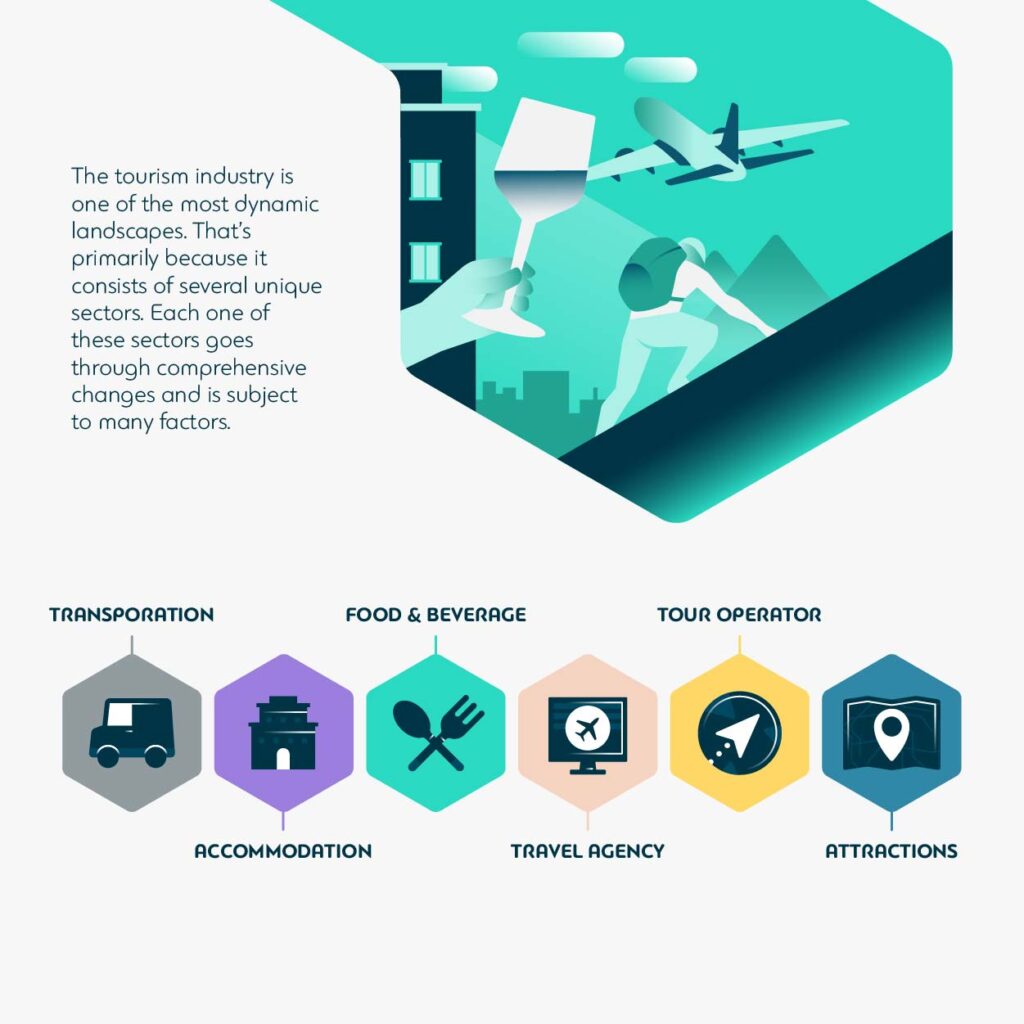
Nevertheless, understanding these sectors is quite essential! Why? Because it can help you make informed business decisions, identify valuable growth opportunities, future-proof your travel brand, and, ultimately, set it up for success.
Below you can find an in-depth analysis of the different sectors in tourism, how they affect each other, and the industry as a whole. Finally, you will discover unique challenges and opportunities for each sector.
The tourism vertical is quite extensive. It consists of six sectors, making it one of the most diverse industries. These sectors are transportation, accommodation, food and beverage, travel agencies, and attractions. Let’s take a closer look at the sectors, their sizes, and their economic impact.
Transportation in Tourism
Transportation in tourism is a big sector. It encompasses a wide range of forms of travel and enables tourists to reach their destinations safely and efficiently. The sub-sectors include air travel, land transportation, and maritime travel.
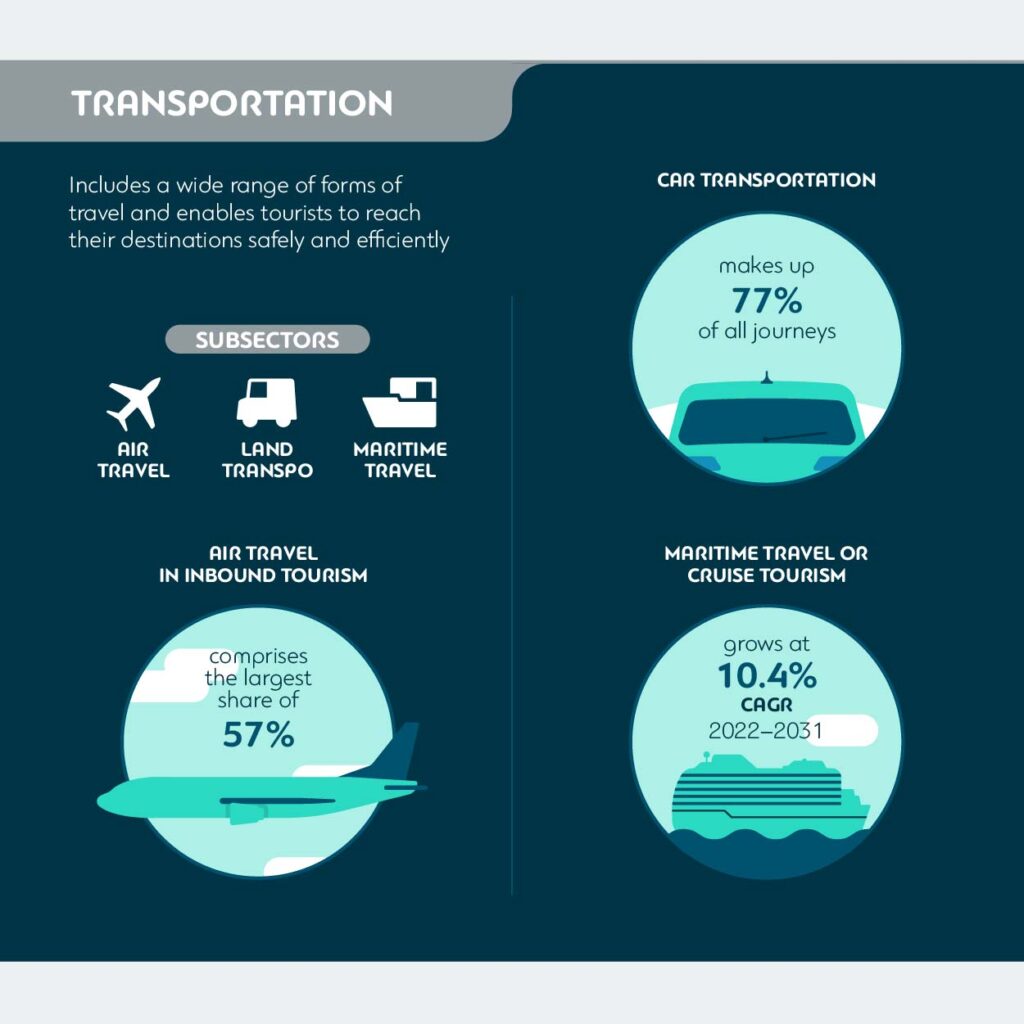
When it comes to inbound tourism, air travel comprises the largest share, 57% . Travelers trying to reach faraway destinations often choose from various travel options. One can actually gauge the momentum of the tourism sector recuperation after the COVID-19 pandemic by looking at air transportation trends. The latest report states that total air traffic is up by 52% compared to 2022 .
Land transportation for tourists has been increasing in recent years. A recent study reveals that car transportation makes up 77% of all journeys . The reasons that explain this trend are flexibility, price, and independence.
Maritime travel or cruise tourism is also experiencing steady growth. This subsector is estimated to continue to grow at a CAGR of 10.4% from 2022 to 2031 .
Transportation is one of the pillars of the tourism industry, and as such, it has a tremendous economic impact on the vertical – its efficient functioning is critical for not only attracting tourists to destinations but also enabling them to reach their desired locations . It allows companies to generate revenue through ticket sales. However, by enabling tourists to reach their destinations, it also drives economic activity in hospitality.
Accommodation in Tourism
All the lodging options tourists can choose from comprise the accommodation subsector of the tourism industry. It includes hotels, resorts, hostels, vacation rentals, Airbnb, and more.
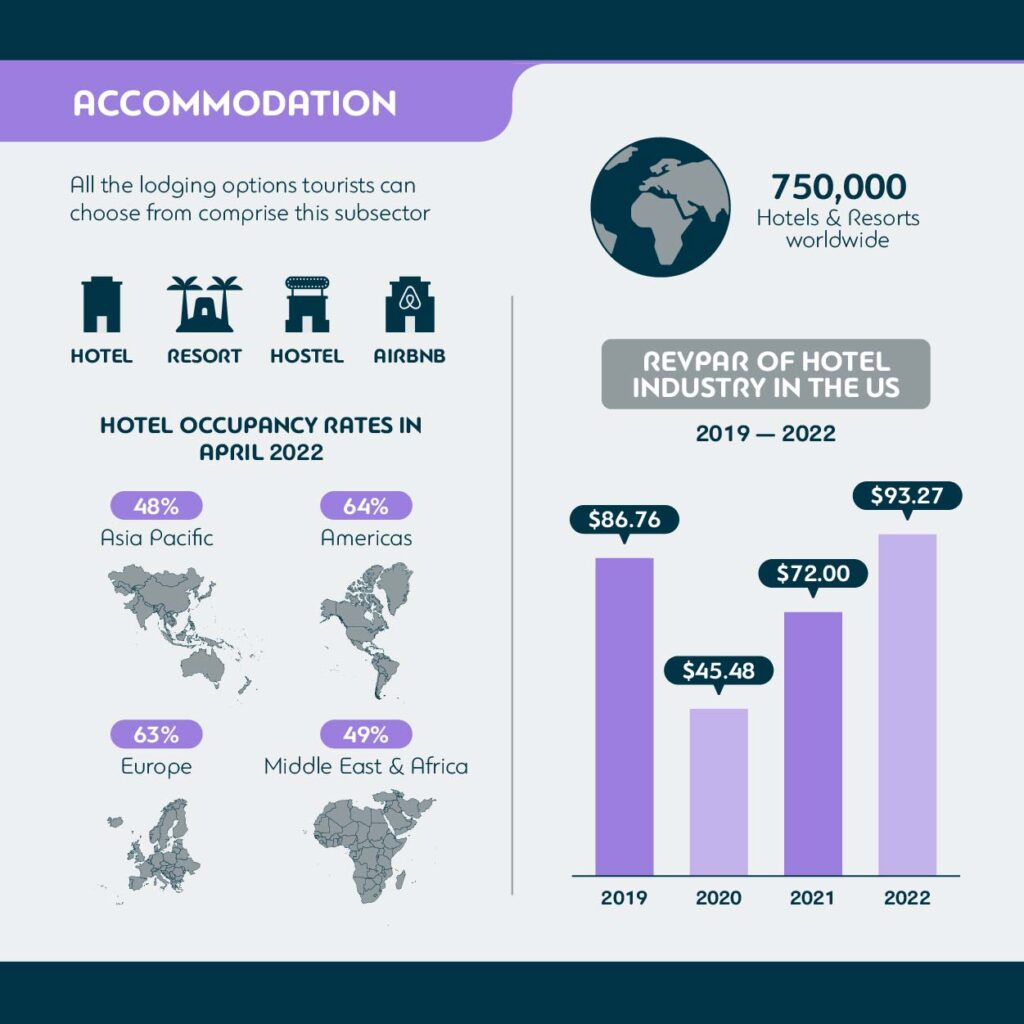
The hotel occupancy rates metric is the best one to keep track of the developments in this subsector simply because there are almost 750,000 hotels and resorts worldwide . In April 2022, hotel occupancy rates were highest in the Americas, reaching 64% . Europe was in second place with the hotel occupancy rates at 63%, followed by the Middle East and Africa at 49% and the Asia Pacific at 48%.
When it comes to the economic impact, the best metric to track is revenue per available room or RevPAR. The RevPar reached $93.27 in 2022, an 8.1% increase compared to 2019 . The average daily rate is up by 13.6%, which makes $148.83 for the same period. Occupancy rates are still not at the pre-pandemic level, but with only a 4.9% difference, they are getting there.
The revenue this sector generates has a tremendous impact. The money is used toward creating new jobs, developing infrastructure, and boosting local economies. Local communities and governments also benefit from the taxes and fees collected from accommodation providers.
Food and Beverage in Tourism
The food and beverage tourism sector is quite diverse and doesn’t just include restaurants and cafes. It also encompasses various dining establishments where tourists can experience local culinary traditions and cuisine.
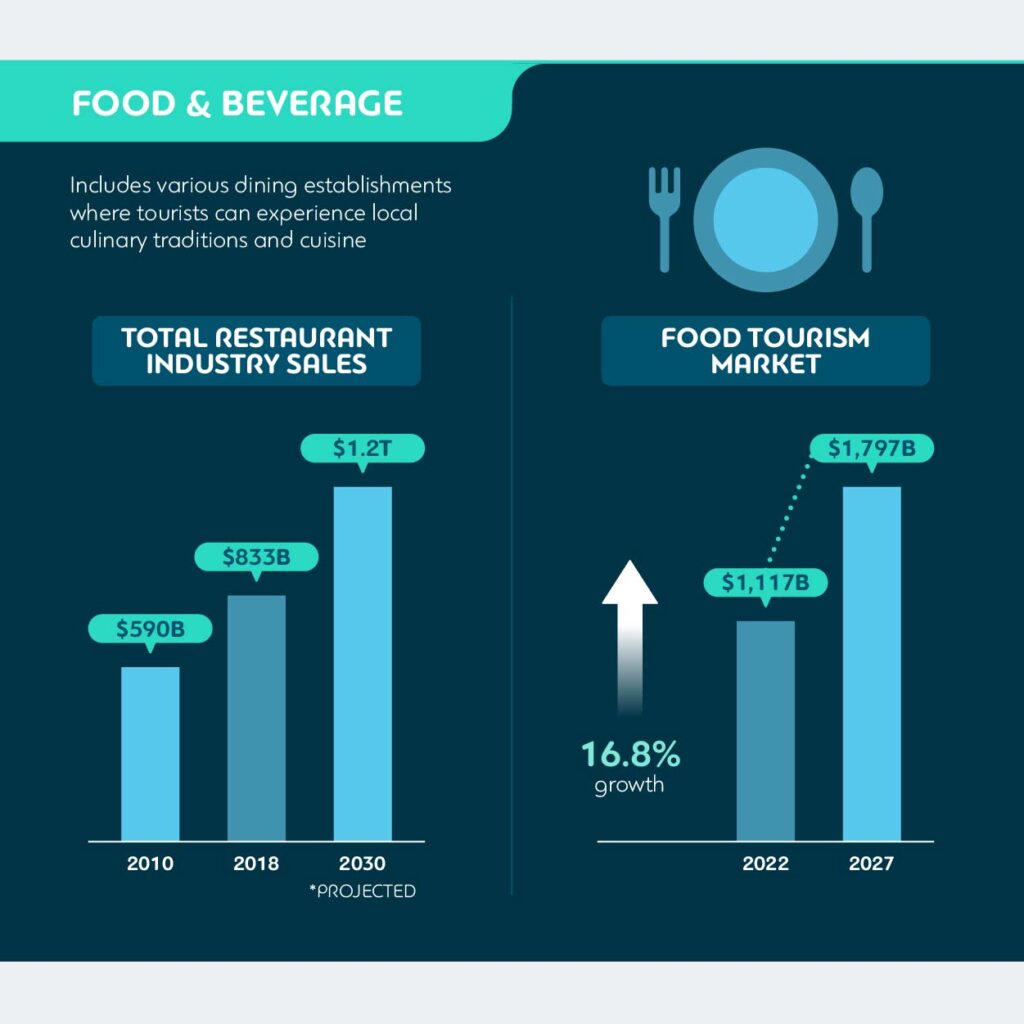
According to the National Restaurant Association research, the sales in the fine dining segment to travelers and visitors went down by 41% . However, total restaurant industry sales are projected to reach $.1.2 trillion by 2030 , and traveler purchases will significantly contribute to this positive development. The food tourism market is projected to reach $1,796.5 billion by 2027 in size, which is a 16.8% growth given that its size in 2022 is $1,116.7 billion.
One of the most extensive studies done recently encompassed the data from over 50,000 travelers to conclude that 64% of travelers base their traveling decisions on the food and drink options available at their destination.
There are two sides to the economic impact of food and beverage in tourism. First, it helps generate more direct revenue, and second, it fosters culinary entrepreneurship and can significantly boost agricultural and food production sectors. It can also help create more job opportunities.
Travel Agencies and Tour Operators
Travel agencies are travel brands that specialize as intermediaries. They provide tourists with access to accommodation and other tourism options. Travel agencies can also offer various services, such as tour packages, accommodation reservations, and transportation booking .
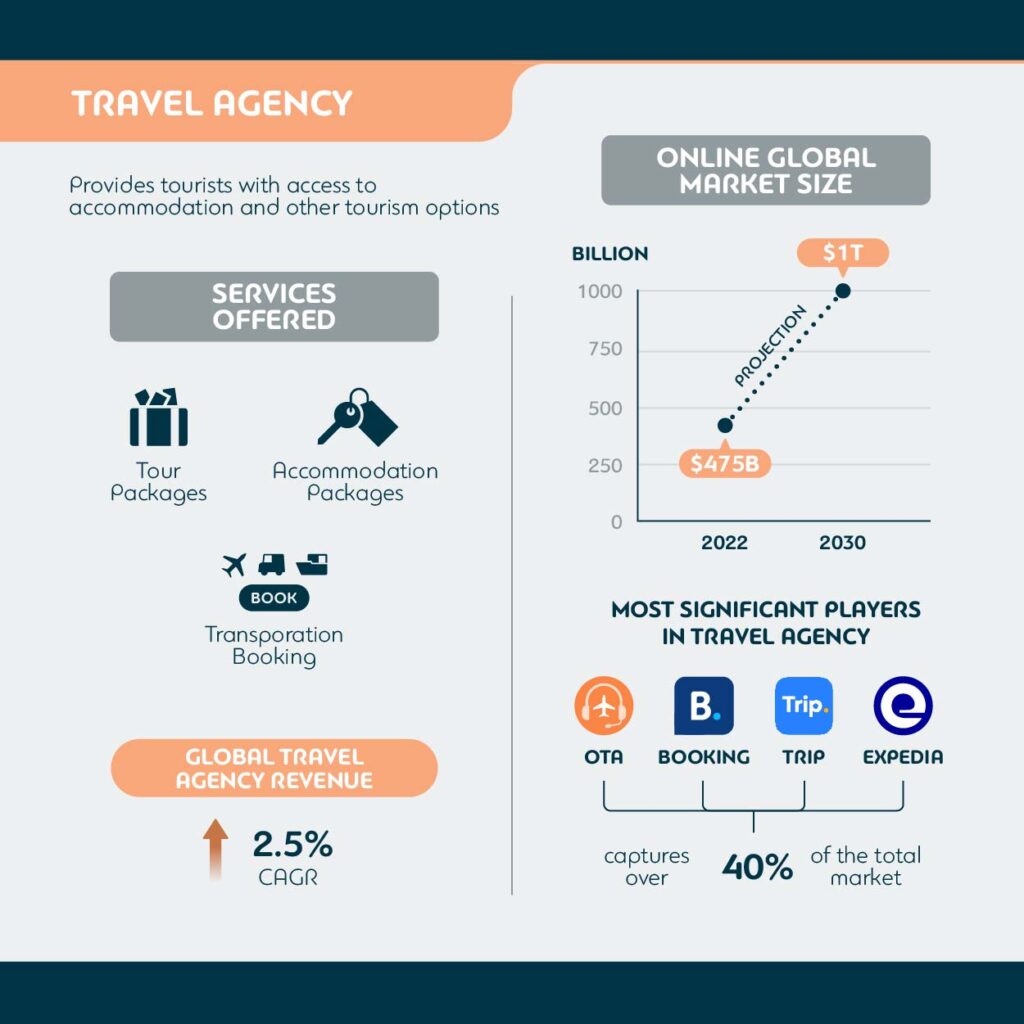
Online travel agencies or OTAs are currently dominating this space. In 2022, the online global travel market size reached $475 billion and is projected to reach over one trillion US dollars by 2030. OTAs, including the most significant players such as Booking.com, Trip.com, and Expedia, captured over 40% of the total market .
While travel agencies continue to generate revenue, it’s important to note that global travel agency revenue is growing at a CAGR of 2.5% .
Travel agencies, both offline and online, are vital parts of the entire travel ecosystem. They both contribute to the whole sector and facilitate tourism overall. Travel agencies stimulate economic activity through other sectors as they are responsible for actually funneling tourists to destinations. They also help create new jobs, improve travel satisfaction, and ensure repeat business.
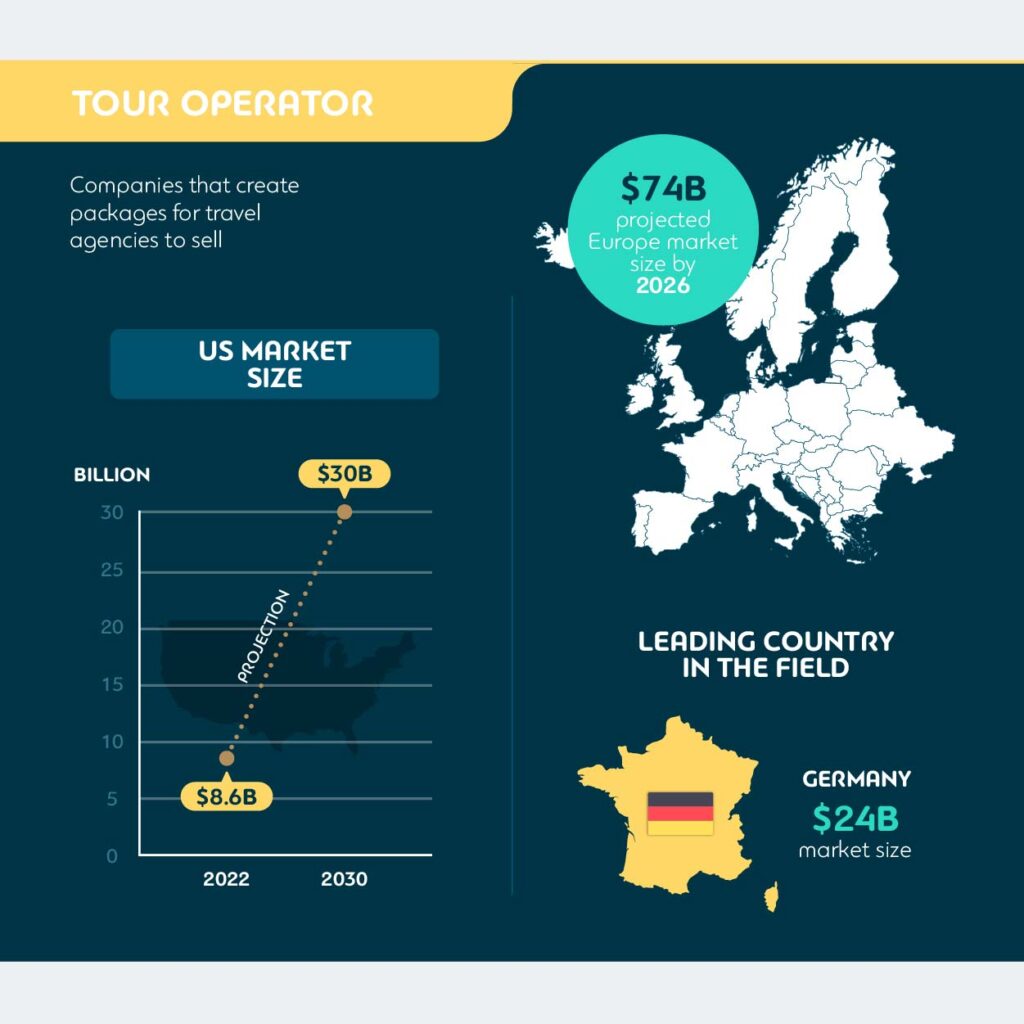
Tour operators, the companies that create packages for travel agencies to sell, also make up a sizable sub-sector. The market size of the tour operators industry in the US in 2022 was $8.6 billion . The US market will continue to grow at a CAGR of 17% to reach $30 billion in size by 2023 . Across the ocean, we have Europe, with its tour operator market size projected to reach $74 billion by 2026 , with Germany as the leader in the field with a market size of $24 billion.
Tourism Attractions
Tourism attraction is a place of interest. Generally speaking, tourism attractions’ primary role is to attract tourists to a particular destination. It can be anything from natural wonders and historical sites to museums and cultural landmarks.
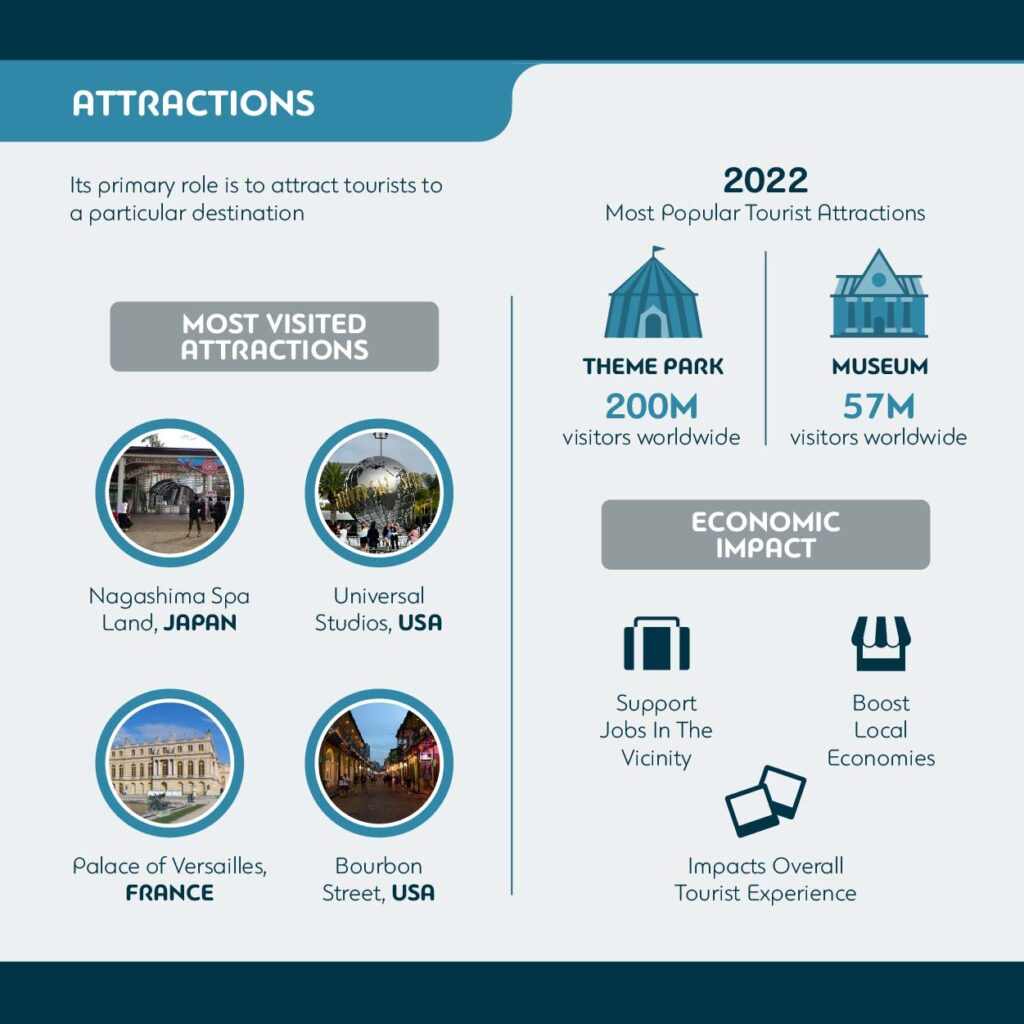
According to the latest data , the most visited attractions are spread across the globe. These include Nagashima Spa Land, Japan; Universal Studio, USA; Palace of Versailles, France; and Bourbon Street, USA.
Theme parks are also among the most popular tourist attractions. In 2022, these parks attracted almost 200 million visitors . The museums are right behind theme parks, with an attendance of 57 million.
Tourism attractions also have a significant economic impact. They support jobs in the vicinity, boost local economies, and positively impact the overall tourist experience. They are also the number one factor that often drives visitation.
The most important thing to understand about sectors in the tourism industry is that they are not separated from one another. In fact, the interplay of sectors in tourism is quite elaborate and happens on so many different levels.
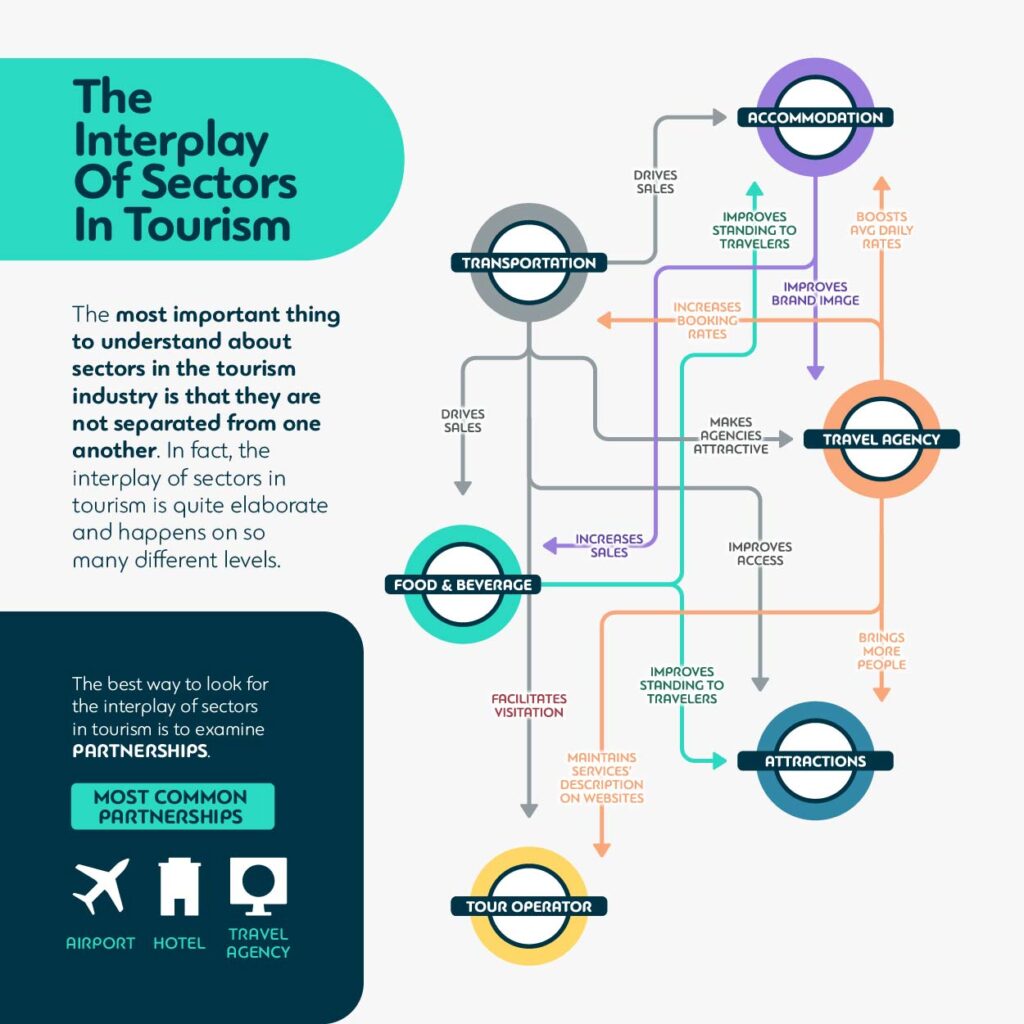
Let’s start with transportation. The affordable, dependable, and reliable means of transportation can facilitate visitation. Transportation is also responsible for the tourist experience. It can improve access to tourism attractions, make tourism agencies more attractive, and drive sales in the accommodation and food and beverage sectors.
Accommodation in tourism often interplays with travel agencies. It can help improve the brand image of a travel agency by enhancing the stay experience. It can also lead to increased food and beverage sales if the hotel or a resort has its own facilities, such as a restaurant or bar. In return, the food and beverage sector can improve the standing of accommodations and destinations in the eyes of travelers.
Travel agencies interplay with all of the sectors. The services they offer have to live up to the descriptions found on the websites. They can help boost the average daily rates for accommodation providers, increase booking rates at transportation companies, and bring more people to attractions.
The best way to look for the interplay of sectors in tourism is to closely examine partnerships. The transportation, accommodation, and other various travel brands have recognized the value of the interplay and decided to partner up to reap even more benefits.
The most common are partnerships between airlines, hotels, and travel agencies. It enables airlines to remain competitive while helping hotels and travel agencies maintain high customer satisfaction and enhanced travel experience.
The real-world example that comes to mind is Wilderness Safaris’ partnership with Qatar Airways . The big hospitality brand wanted its guests to arrive well-fed & rested, ready to engage in adventures in the great outdoors. Given that Qatar Airways received high marks in the catering and business class areas, it was the perfect pick for Wilderness Safaris.
Another real-world example is AEGAN’s partnership with Booking.com. Here, we have a transportation company and OTA joining forces together to reap unique benefits. AEGAN, an airline brand, wanted its customers to be able to conveniently check hotel availability in real-time, book accommodation at competitive prices, and benefit from friendly cancellation policies.
To encourage travelers to choose AEGAN services through Booking.com, the company also launched the Frequent Flyer Program and awarded consumers extra miles with every hotel booking using AEGAN transportation services.
As one of the largest industries, the tourism vertical contributes 10% of all jobs or 333 million . All sectors contribute to job creation and the global tourism market size of $2.4 trillion .
Accommodation and food and beverage sectors have a significant impact on the tourism industry as well. In terms of GDP, these sectors contributed 3.3% , a significant growth, given that the US average is 2.87% .
In raw numbers, it looks like the following. Global accommodation in tourism generates $903 billion . Almost half of it, 49%, comes from the USA sector. Europe, APAC, Middle East, and Africa contribute with their shares of 25%, 22%, 3%, and 2%, respectively. The global hotel and resort industry currently employs approximately 10.5 million people .
The global travel agency services industry’s revenue has reached $475 in 2023 . Travel agencies in the US employ 402,835 people. Over the last 5 years, the number of people working in the travel agency sector went up by 12%. On a global scale, travel agencies employ approximately 2 million people .
While every industry and sub-sector is unique, they all share a few things in common. In each one of them, you can find a couple of opportunities and encounter a few challenges. Let’s see what challenges and opportunities there are in each sector.
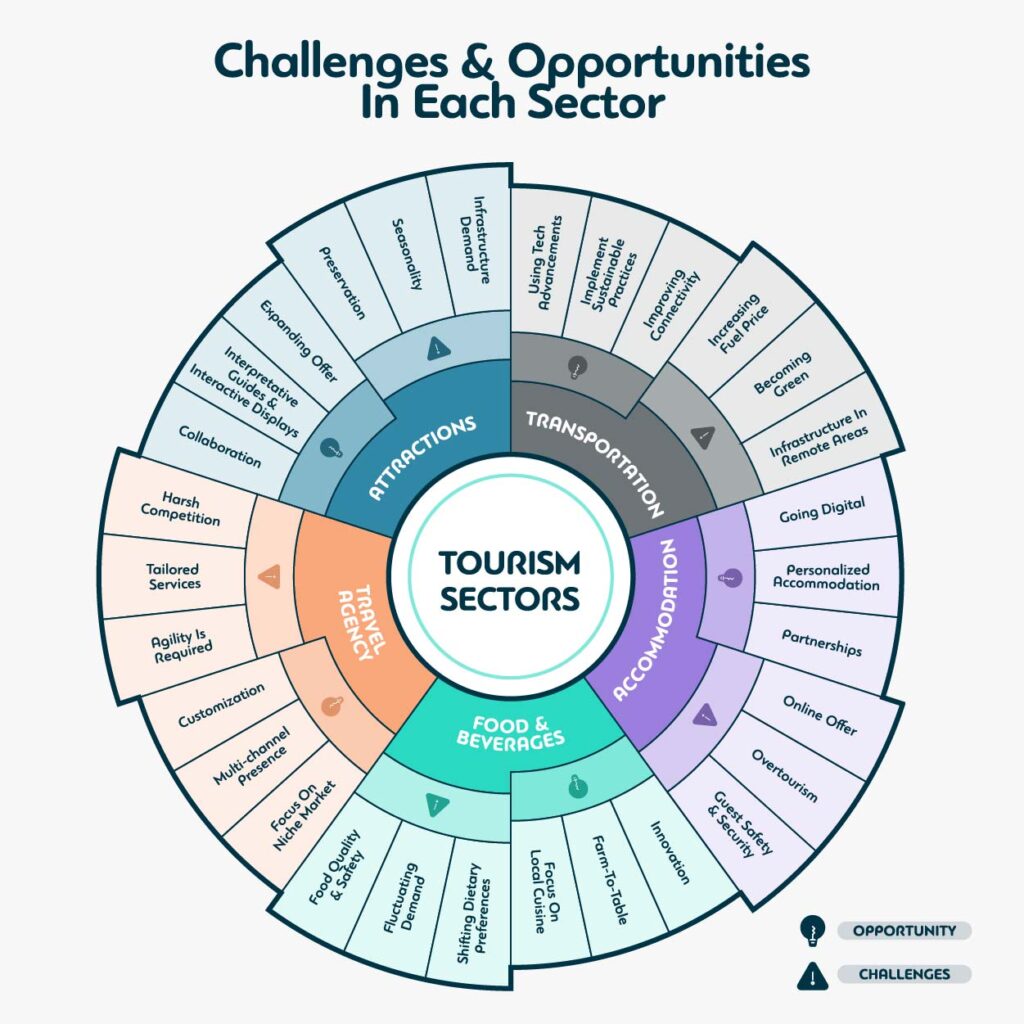
Transportation in tourism
Challenges:
- Ever-increasing prices of fuel – to remain profitable, airlines need to manage operational costs, and one of the enormous costs is fuel;
- Becoming green – transportation companies need to reduce carbon emissions and adopt sustainable travel practices, which can be challenging and costly;
- Infrastructure in remote destinations – building roads and developing infrastructure can be pretty challenging in remote destinations with tremendous tourism potential.
Opportunities:
- Using technological advancements – transportation technologies can help improve customer experience and improve operational efficiencies;
- Implementing sustainable practices – becoming eco-friendly can help brands attract environmentally conscious travelers;
- Improving connectivity – with connectivity expansion, transportation brands can help local economies and create new tourism opportunities.
Accommodation in tourism
- Online offer – as more and more competitors join online marketplaces, accommodation providers need to embrace a new paradigm;
- Overtourism – limited accommodation capacity is a massive problem in destinations where over-tourism is a norm;
- Guest safety and security – in some situations and locations, accommodation providers can struggle with ensuring guest safety and security.
- Going digital – embracing cutting-edge technologies can help enhance guest experience and ensure longer and repeat stays;
- Personalized accommodation – offering boutique and experiential lodging can help accommodation providers cater to modern travelers;
- Partnerships – aligning with relevant companies and local brands can help providers attract more travelers.
Food and beverage in tourism
- Quality and safety of food – upholding the highest food quality and safety standards can be challenging;
- Fluctuating demand – seasonal destinations can struggle with handling fluctuating food and beverage demand;
- Shifting dietary preferences – guests may have diverse dietary preferences, which require planning and management.
- Innovation – innovative dishes and fusion cuisines can attract guests who feel more adventurous;
- Farm-to-table – cooperating with local farmers can help bring fresh ingredients to restaurants;
- Focus on local cuisine – bringing local dishes into the spotlight can help attract people interested in authentic cuisine.
Travel agencies
- Harsh competition – travel agencies have to compete against hundreds of online travel booking platforms;
- Tailored services – many travelers look for personalized experiences, which can prove hard to provide if you are a small agency;
- Agility is required – getting ready for a wide range of disruptions is costly and hard to sustain at scale.
- Customization – offering unique packages can help generate more bookings;
- Multi-channel presence – being present across online and offline channels is paramount;
- Focus on a niche market – staying focused on a specific travel niche can help you truly cater to the needs of your target customers.
Tourism attractions
- Preservation – sustainable management of tourism attractions can be challenging;
- Seasonality – if traction generates the majority of the revenue through seasonal visitors, it can be a problem;
- Infrastructure demand – a growing number of visitors can cause infrastructure strain.
- Collaboration – partnerships can help create a better ecosystem;
- Interpretive guides and interactive displays – interpretive experiences can delight a wide range of visitors;
- Expanding offer – You can offer new activities to make the offer more attractive.
As you can see, the tourism industry landscape is quite comprehensive, with a lot of moving pieces on the board, and the best way to understand the vertical is to take a look at its subsectors.
Hopefully, now you understand transportation, accommodation, food and beverage, travel agencies, and tourism attraction sectors better. They are all intertwined, with many interplay activities. While the tourism sector comes with its fair share of challenges, there are also many opportunities. The current stats and projections tell us that all subsectors are prosperous and expected to grow in the foreseeable future.

Subscribe to our newsletter
Yay you are now subscribed to our newsletter.

Marc Truyols has a degree in Tourism from the University of the Balearic Islands. Marc has extensive experience in the leisure, travel and tourism industry. His skills in negotiation, hotel management, customer service, sales and hotel management make him a strong business development professional in the travel industry.
Mize is the leading hotel booking optimization solution in the world. With over 170 partners using our fintech products, Mize creates new extra profit for the hotel booking industry using its fully automated proprietary technology and has generated hundreds of millions of dollars in revenue across its suite of products for its partners. Mize was founded in 2016 with its headquarters in Tel Aviv and offices worldwide.
Related Posts

Empowering Equality: Mize Leads the Way in Travel Technology
7 min. Are we all equal? Are we all equally represented in the business world? In some professional sectors, there might still be some under-representation of women, minorities, and the LGBTQIA+ community. The tech sphere is no different, but is the travel tech sector a spark of hope? As the business world becomes more diverse, […]

Slow Tourism Case Studies: Examples to Truly Understand Slow Tourism
14 min. The tourism industry is moving at an ever-accelerating pace. That’s because the tourism industry is perhaps one of the verticals that depend on the most factors. One of the main factors that affect it is social movements, given that tourism brands of all sizes always cater to the needs of consumers. One of […]

All About the 5 Top Travel Agencies in China
20 min. One of today’s largest travel markets was practically nonexistent between 1949 and the 1970s. Yes, the Chinese travel market didn’t exist because the People’s Republic was entirely closed to travelers until the late 1970s. However, it’s not the only thing that makes this market exciting and inviting for a closer look. In 2012, […]
Winter is here! Check out the winter wonderlands at these 5 amazing winter destinations in Montana
- Travel Tips

What Are The 7 Sectors Of Tourism
Published: December 12, 2023
Modified: December 28, 2023
by Mable Roldan
- Travel Guide
Introduction
Welcome to the exciting world of tourism! As travel enthusiasts, we often embark on journeys to discover new destinations, experience different cultures, and create unforgettable memories. But have you ever wondered about the various sectors that make up the tourism industry? Understanding these sectors can help us gain insight into the complex web of services and experiences that come together to create the perfect travel experience.
The tourism industry encompasses a wide range of activities and services, all aimed at providing travelers with comfortable and enjoyable experiences. These sectors work harmoniously to ensure that every aspect of a trip, from accommodation to transportation and beyond, is well taken care of. In this article, we will explore the seven key sectors of tourism, each playing a vital role in the overall travel experience.
From finding the perfect place to stay, to indulging in delectable local cuisine, to getting around efficiently, each sector offers unique services and experiences that contribute to the overall success of a trip. So, let’s dive into the world of tourism sectors and discover how they come together to create unforgettable journeys!
Accommodation Sector
The accommodation sector is a fundamental pillar of the tourism industry, providing travelers with a home away from home during their travels. This sector comprises a diverse range of options, ranging from luxurious hotels and resorts to budget-friendly hostels and vacation rentals.
Accommodation providers strive to ensure that guests have a comfortable and pleasant stay by offering a variety of amenities and services. From well-appointed rooms and spacious suites to 24/7 reception and room service, the accommodation sector aims to meet the needs and preferences of all types of travelers.
In recent years, there has been a remarkable surge in alternative accommodation options such as home-sharing platforms like Airbnb, allowing travelers to rent unique properties directly from homeowners. This trend has provided travelers with a wider range of choices and the opportunity to experience local neighborhoods and cultures more authentically.
Additionally, sustainability and eco-consciousness have become important factors in the accommodation sector. Many establishments are implementing eco-friendly practices, such as energy-efficient lighting and recycling programs, to reduce their environmental impact and attract guests who prioritize sustainable tourism.
Furthermore, technology has played a significant role in enhancing the accommodation sector. Online booking platforms and mobile apps have made it easier than ever for travelers to research, compare, and book accommodations, providing a seamless experience. The use of keyless entry systems and personalized mobile concierge services have also become popular, allowing guests to have a hassle-free and customized stay.
Whether it’s a cozy bed and breakfast nestled in a charming countryside or a luxurious beachfront resort with stunning ocean views, the accommodation sector offers a wide range of options to suit every budget, preference, and travel style.
Food and Beverage Sector
The food and beverage sector is a vital component of the tourism industry, as it provides travelers with culinary experiences that reflect the local culture and traditions of a destination. This sector encompasses a wide range of establishments, including restaurants, cafes, bars, food trucks, and street food vendors.
One of the highlights of travel is indulging in diverse cuisines and trying new flavors. The food and beverage sector caters to these cravings by offering a plethora of dining options, from upscale fine dining restaurants to casual eateries serving traditional local dishes. Travelers can savor authentic flavors, culinary masterpieces, and innovative fusions that highlight the region’s unique gastronomy.
Many destinations are known for their vibrant food scenes, with local markets and street food stalls offering a rich tapestry of flavors and aromas. Exploring local markets and trying street food can be a memorable and immersive experience, allowing travelers to get a taste of the authentic culinary culture of a place.
The food and beverage sector also caters to specific dietary needs and preferences. With an increasing number of people following vegetarian, vegan, or gluten-free diets, many establishments now offer diverse menu options to accommodate various dietary requirements. This inclusivity ensures that travelers with dietary restrictions can still enjoy delicious meals and be part of the culinary exploration.
Moreover, the sector has witnessed a rising trend of farm-to-table dining and emphasis on local, sustainable ingredients. Restaurants and cafes are partnering with local farmers, growers, and producers to source fresh, seasonal ingredients, supporting the local economy and reducing the carbon footprint associated with long-distance food transportation.
Technology has also made its mark on the food and beverage sector, with online restaurant reviews, recommendations, and food delivery apps allowing travelers to discover and enjoy the best dining experiences effortlessly. Additionally, some establishments employ innovative concepts like interactive dining experiences, fusion cuisines, and molecular gastronomy, aiming to provide unique and memorable meals that go beyond traditional dining.
From savoring Michelin-starred delicacies to sampling street food treasures, the food and beverage sector offers a diverse and enticing array of culinary experiences for travelers to delight their taste buds and create lasting memories.
Transportation Sector
The transportation sector is an essential component of the tourism industry, connecting travelers to their desired destinations. It encompasses various modes of transportation, including air travel, train and rail services, bus and coach services, cruises, and car rentals.
Air travel is a major player in the transportation sector, providing international and domestic flights that enable travelers to reach their destinations quickly and efficiently. Airlines strive to offer comfortable seating, in-flight entertainment, and quality service to enhance the overall travel experience. With the expansion of low-cost carriers, air travel has become more accessible and affordable, driving tourism growth around the world.
Train and rail services are another popular mode of transportation, especially for intercity travel and scenic journeys. Traveling by train allows passengers to enjoy stunning landscapes, experience local culture, and connect with different regions or countries in a convenient and sustainable way.
Bus and coach services provide economical transportation options for both urban and rural areas. They are often preferred by budget-conscious travelers or those seeking a more immersive experience, as they allow passengers to interact with locals and witness the changing landscapes along the journey.
Cruise tourism has also gained popularity, offering unique travel experiences on sea voyages. Cruise ships provide a floating resort-like experience, with amenities such as restaurants, entertainment venues, and recreational activities, while allowing travelers to explore different destinations without the need for constant packing and unpacking.
Car rentals give travelers the freedom to explore at their own pace, particularly in destinations with extensive road networks and scenic drives. Renting a car allows for flexibility and the opportunity to venture off the beaten path, discovering hidden gems and experiencing a more personalized travel itinerary.
Advancements in technology have revolutionized the transportation sector, making it more convenient and accessible for travelers. Online platforms and mobile apps allow for seamless booking and ticketing, real-time travel updates, and navigation assistance. Ride-hailing services have also gained popularity, providing an alternative mode of transportation in urban areas.
Transportation plays a crucial role in shaping a traveler’s overall experience, as it sets the tone for their journey and connects them to the various attractions and activities of a destination. Efficient and well-connected transportation networks contribute to the accessibility and attractiveness of a place, making it easier and more enjoyable for travelers to explore and immerse themselves in new cultures and experiences.
Travel Agency Sector
The travel agency sector plays a pivotal role in the tourism industry, acting as a bridge between travelers and their dream destinations. Travel agencies provide valuable services and expertise to help travelers plan and organize their trips, ensuring a smooth and hassle-free experience.
Travel agencies serve as a one-stop-shop for all travel-related needs. They assist travelers in selecting destinations, finding the best deals on accommodations, arranging transportation, and curating itineraries based on individual preferences and budgets. Whether it’s a solo adventure, a family vacation, a romantic getaway, or a group tour, travel agencies cater to a wide range of travel styles and requirements.
These agencies maintain relationships with airlines, hotels, tour operators, and other service providers, enabling them to secure discounted rates and exclusive packages for their clients. They have firsthand knowledge of destinations, attractions, and local customs, allowing them to offer valuable advice and recommendations to travelers.
In addition to organizing the logistics of a trip, travel agencies often specialize in specific types of travel experiences. They may focus on adventure travel, luxury vacations, cultural immersion, or niche markets like eco-tourism or culinary tours. This specialization allows them to provide expert guidance tailored to the specific interests of their clients.
With the rise of online travel booking platforms, some may question the relevance of travel agencies. However, travel agencies still hold a significant advantage with their personalized service and expertise. They can offer valuable insights and recommendations, handle complex itineraries, and provide support in the event of any unexpected issues during the trip.
Furthermore, travel agencies often offer additional services such as travel insurance, visa assistance, and 24/7 customer support. These added benefits alleviate the stress and uncertainties that can arise when planning and embarking on a journey, giving travelers peace of mind.
In recent years, travel agencies have also embraced technology to enhance their services. Many agencies have online platforms where travelers can research, compare, and book travel services. They utilize social media and content marketing strategies to inspire and engage potential clients, sharing travel tips, destination highlights, and special offers.
Overall, the travel agency sector plays a vital role in facilitating seamless and enjoyable travel experiences. Their expertise, personalized service, and access to exclusive deals make them valuable partners for travelers seeking professional assistance and guidance in planning their adventures.
Adventure and Recreation Sector
The adventure and recreation sector of the tourism industry caters to thrill-seekers and outdoor enthusiasts, offering a wide range of exciting activities and experiences. This sector is perfect for those looking to step out of their comfort zone, immerse themselves in nature, and create unforgettable memories.
Adventure tourism encompasses activities such as hiking, mountaineering, rock climbing, zip-lining, white-water rafting, and paragliding, among others. These activities provide a unique opportunity to explore natural landscapes, challenge oneself physically and mentally, and appreciate the beauty and wonders of the great outdoors.
Recreation tourism, on the other hand, focuses on leisure and relaxation. This sector includes activities such as beach vacations, golfing, spa retreats, wellness retreats, and wildlife safaris. Recreation tourism offers a chance to unwind, rejuvenate, and engage in activities that promote overall well-being and tranquility.
While adventure and recreation activities differ in their nature, both sectors contribute to sustainable tourism by raising awareness about environmental conservation and supporting local communities. Many adventure tourism operators and recreational facilities follow sustainable practices, ensuring the preservation of natural resources and the protection of delicate ecosystems.
Adventure and recreation tourism also provide economic opportunities for local communities. These activities often require specialized guides, equipment rental services, and accommodation facilities, creating employment and generating income for the host destinations.
Technology has played a significant role in the growth of the adventure and recreation sector. Online platforms and mobile applications make it easier for travelers to research and book activities, access trail maps, and connect with local guides. Adventure and recreation companies often leverage social media platforms to showcase their offerings and inspire potential travelers.
The adventure and recreation sector offers a diverse range of experiences, catering to a variety of interests and skill levels. Whether it’s summiting a mountain peak, scuba diving in a vibrant coral reef, or simply enjoying a peaceful yoga retreat, this sector ensures that travelers can find activities that align with their preferences and desired level of excitement.
It’s important to note that safety and responsible tourism practices are essential in the adventure and recreation sector. Travelers should choose licensed operators, follow guidelines provided by professionals, respect the environment, and prioritize their own safety and well-being while engaging in adventurous activities. This ensures a positive and sustainable experience for both travelers and the destinations they visit.
Events and Conferences Sector
The events and conferences sector of the tourism industry plays a pivotal role in bringing together professionals, enthusiasts, and like-minded individuals from various fields. This sector is responsible for organizing and hosting a wide range of events, conferences, trade shows, and exhibitions that contribute to knowledge-sharing, networking, and business growth.
Events and conferences serve as platforms for professionals to exchange ideas, showcase innovations, and discuss current trends in their respective industries. They provide opportunities for networking, collaboration, and learning, fostering professional development and driving innovation.
The sector encompasses a diverse range of events, including academic conferences, industry exhibitions, music festivals, sports competitions, cultural festivals, and trade shows, among many others. These events attract participants from different parts of the world, contributing to the economic growth of the host destination.
Events and conferences often require specialized infrastructure and facilities, such as convention centers, exhibition halls, and hotels with conference facilities. These venues provide the necessary space, technology, and amenities to accommodate large gatherings and ensure the smooth execution of events.
The events and conferences sector contributes to the tourism industry by boosting visitor numbers, filling hotel rooms, and driving revenue for local businesses such as restaurants, transportation services, and event vendors. Host destinations often see a surge in tourism during major events, as attendees explore the local attractions and contribute to the local economy.
Technology has played a significant role in enhancing the events and conferences sector. Virtual conferences and hybrid event formats have gained popularity, allowing participants to attend events remotely, reducing travel expenses and environmental impact. Event management software, mobile apps, and online registration systems have streamlined event organization, making it easier for attendees to access event information, sign up for sessions, and engage with other participants.
It’s important to note that the events and conferences sector is not limited to business-related gatherings. Cultural festivals, music concerts, and sporting events also fall under this sector, offering unique experiences that celebrate art, music, sports, and local traditions.
A well-executed event or conference can leave a lasting impact on participants, fostering professional connections, knowledge exchange, and inspiration. By bringing people together, this sector contributes to the growth and development of various industries and promotes cultural exchange and mutual understanding.
Tourism Services Sector
The tourism services sector is a vital component of the overall tourism industry, providing a wide range of support services to both travelers and businesses operating within the tourism sector. This sector encompasses various services that enhance the travel experience and contribute to the seamless operation of the industry.
One of the key services in this sector is tourism information and assistance. Tourism information centers, both physical and virtual, provide valuable resources and guidance to travelers, offering information about destinations, attractions, accommodation options, transportation, and activities. These centers play a crucial role in helping travelers plan their itineraries and make informed decisions.
Another important aspect of the tourism services sector is travel insurance. Travel insurance provides coverage for unexpected events such as trip cancellations, medical emergencies, lost baggage, and travel interruptions. It offers peace of mind to travelers, ensuring that they are protected from unforeseen circumstances that may disrupt their travel plans.
Visa assistance is another significant service within this sector. Many destinations require travelers to obtain visas before entry, and navigating the visa application process can be complex and time-consuming. Visa assistance services, whether provided by travel agencies or specialized companies, help travelers understand the requirements, gather the necessary documentation, and facilitate the visa application process.
Translation and interpretation services are also essential in the tourism services sector, particularly in destinations where the local language may be a barrier for some travelers. These services ensure effective communication between travelers and local residents, allowing for a smoother and more immersive experience.
Additionally, currency exchange services play a vital role in facilitating financial transactions for travelers. The ability to exchange currencies conveniently and at fair rates ensures that travelers have access to the local currency for their expenses during their trip.
Technology has transformed the tourism services sector, making these services more accessible and convenient. Mobile applications, online platforms, and virtual assistants provide travelers with instant access to information, assistance, and services. Many travel service providers offer online booking options and 24/7 customer support, allowing travelers to make reservations and address any queries or concerns at their convenience.
The tourism services sector acts as a backbone for the overall tourism industry, ensuring that travelers have access to the necessary support, information, and services they need throughout their journey. By providing valuable assistance and enhancing the travel experience, this sector plays a vital role in fostering customer satisfaction and driving the growth of the tourism industry as a whole.
The tourism industry is a complex and multifaceted sector, composed of various interconnected sectors that work together to provide unforgettable travel experiences. From accommodations and food to transportation and events, each sector plays a crucial role in shaping the overall travel experience and contributing to the success of the tourism industry.
The accommodation sector ensures that travelers have a comfortable and enjoyable place to stay, offering a wide range of options to suit every preference and budget. The food and beverage sector tantalizes taste buds with diverse cuisines and culinary experiences, reflecting the local culture and traditions of a destination.
The transportation sector connects travelers to their desired destinations, providing convenient and efficient modes of travel. Travel agencies serve as invaluable resources, offering expertise and assistance in planning and organizing trips, while the adventure and recreation sector caters to thrill-seekers and outdoor enthusiasts craving adrenaline-pumping experiences.
Events and conferences bring professionals together, fostering knowledge sharing, networking, and innovation. Finally, the tourism services sector provides essential support services such as information and assistance, travel insurance, visa facilitation, translation and interpretation, and currency exchange.
Technology has revolutionized the tourism industry, making information and services more accessible, convenient, and personalized. Online booking platforms, mobile apps, and virtual assistance have transformed the way travelers research, plan, and book their trips.
In conclusion, understanding the various sectors of the tourism industry allows us to appreciate the intricate web of services that work harmoniously to create remarkable travel experiences. Whether it’s relaxing in a luxurious hotel, savoring local delicacies, exploring beautiful landscapes, attending a conference, or receiving helpful assistance, each sector contributes to the success and enjoyment of a trip. By recognizing the importance of these sectors and embracing technology’s advancements, we can continue to enhance and evolve the tourism industry and provide unforgettable experiences for travelers around the world.

- Privacy Overview
- Strictly Necessary Cookies
This website uses cookies so that we can provide you with the best user experience possible. Cookie information is stored in your browser and performs functions such as recognising you when you return to our website and helping our team to understand which sections of the website you find most interesting and useful.
Strictly Necessary Cookie should be enabled at all times so that we can save your preferences for cookie settings.
If you disable this cookie, we will not be able to save your preferences. This means that every time you visit this website you will need to enable or disable cookies again.

Components of tourism: Structure of the tourism industry
Disclaimer: Some posts on Tourism Teacher may contain affiliate links. If you appreciate this content, you can show your support by making a purchase through these links or by buying me a coffee . Thank you for your support!
The travel and tourism industry is argued by many as being the largest industry in the world. It is, therefore, no surprise that the structure of the tourism industry is quite complex, involving many components of tourism.
With many different types of tourism and types of businesses operating within the tourism industry, from private companies to charities and NGOs, the structure of the tourism industry is made up of many different segments and components.
In this article I will provide you with an overview of the structure of the tourism industry, outlining the types of organisations and stakeholders in tourism that are involved.
Structure of the tourism industry
Components of tourism, international organisations, national tourist boards, regional tourist boards, tourist information centres, travel by air, travel by road, travel by train, travel by water, hotels chains, hostels and budget accommodation, holiday parks and campsites, accommodation innovations, world travel market, football world cup, glastonbury, holi festival, day of the dead, natural attractions, built attractions, tour operators, travel agents, ancillary services, components of tourism | structure of the tourism industry, structure of the tourism industry | components of tourism: further reading.
The importance of tourism is demonstrated when you can see how big the industry is!
The structure of the industry is made up of several components of tourism and involves many different stakeholders. These components are all interrelated in one way of another. The components of tourism make up the entire tourism system.

There are several integral components of tourism. Without these components, the tourism industry would struggle to function. I have explained what this means below, but before you read on, take a look at this short video that I made (and if you like what you see, don’t forget to subscribe to my YouTube channel)!
This was demonstrated, for example, during the Coronavirus pandemic, which halted air travel around the world. Travel services are a vital component of tourism and without these services being operational, the tourism industry struggled to survive!
There are six major components of tourism, each with their own sub-components. These are: tourist boards, travel services, accommodation services, conferences and events, attractions and tourism services.

Below, I will explain what each of the components offer to the tourism industry and provide some relevant examples.
Components of tourism: Tourist boards
A tourist board is an essential component of tourism and an integral part of the structure of the tourism industry.
A tourism board is responsible for the promotion of tourism in a particular area. This could be a city, a region, a country or a group of countries.
A tourism board is usually Government funded and is usually a public travel and tourism organisation (although this is not always the case).
A tourism board is also often referred to as a Destination Marketing Organisation (DMO).
Most tourist boards focus on promoting tourism in a particular area, city or country. There are, however, some organisations which aim to promote tourism across more than one country.
Whilst these organisation often have many functions other than tourism, they will also play a role in the promotion of tourism in particular parts of the world. This could include the European Union , the ASEAN network or organisations such as the United Nations.
A national tourist board is a national organisation whose aim is to promote tourism across the country.
There are usually several management bodies that are involved with a national tourist board. They are essential stakeholders who determine many aspects of tourism in the country, such as budgets, taxation and regulations.
Said management bodies include the parliament, the tourist board, an auditing committee and the Prime Minister, President or Head of State.
The national tourist board is funded from tourist taxes, membership fees, Government funding and other sources.
Examples of national tourist boards (often most commonly referred to by their ‘campaign title’ as opposed to the Government title) include Visit Britain , Incredible India and Amazing Thailand .
A regional tourist board is a tourist board that focusses on a particular region of a country. They are often a sub-division of a country’s national tourist board.
Regional tourism boards are often funded and operated in the same way as national tourist boards.
Examples of successful regional tourism boards include: Visit Cornwall in the UK, Kerala Tourism in India, Visite Montreal in Canada and Cape Town Tourism in South Africa.
A tourist information centre is the place where tourists can go for advice and help with regards to all matters related to tourism in the area.
In the tourist information centre (TIC) you will find staff who are knowledgeable about the local area. There will often be a range of printed and digital information for you, including leaflets, maps, coupons and guidebooks. Sometimes there will be virtual tourism facilities.
Tourist information centres have been an important component of tourism throughout the history of travel and tourism , however, they are coming under increasing pressure as a result of information that is available online. This has resulted in fewer people visiting TICs in person.
Most major tourist areas will have a tourist information centre. These are usually centrally located.
Tourist information centres are funded by the local Government.
Other posts that you might be interested in: – What is tourism? A definition of tourism – The history of tourism – Stakeholders in tourism – Dark tourism explained – What is ABTA and how does it work? – The economic impacts of tourism
Components of tourism:Transport services
The relationship between transport and tourism is strong.
According to the most commonly accepted definitions of tourism, a person must travel away from their home environment for at least one night in order to be a tourist (although I would argue that this definition needs updating given that it doesn’t account for novel forms of tourism such as a staycation or virtual tourism ).
Based on this fact, therefore, transport is an integral component of tourism. Without transport, people cannot reach their intended destination.
There are a range of different transport types. The most common and popular methods of transport that make up the structure of the tourism industry, however, are: air, road, train and water .

Travel by air has grown exponentially in the past few decades. With the introduction of low cost airlines and deregulation, the competitive market has been a tourist’s paradise.
New routes opening up has introduced tourists to areas that they may never have been able to reach before and low prices have resulted in more of us taking more trips abroad using air travel as our means of transportation.
Travel by air is an essential component of tourism and this was demonstrated during the Coronavirus epidemic. During this time most air traffic was halted, which had a devastating impact of the tourism industry world-wide.
Travel by road is also a core component of tourism, particularly for domestic tourism .
Travel by road is more popular in some countries than others. This largely depends on accessibility options (i.e. what is accessible by road), distances required and road conditions.
In destinations where travel by road is popular, there are often many car hire or rental companies.
Travel by train is very popular in destinations that have good rail networks in infrastructure.
In some parts of the world, such as China and Japan, there are world-class high-speed railways that can be more efficient than flying.
In other parts of the world, the rail journey is part of the tourism experience. A good example of this is the Siberian Railway.
In Europe you can buy an affordable interrail pass , which allows you to travel throughout Europe using the rail system.

Travel by water is also an important component of tourism.
The structure of the tourism industry includes cruises, ferries and leisure boats, among other types of travel by water.
Travel by water can vary considerably in price and can include anything from a round the world cruise to a short long tail ride in Thailand .
Components of tourism: Accommodation services
Accommodation services make up an important part of the structure of the tourism industry.
Whilst accommodation services were traditionally focussed mainly around the hotel industry, nowadays accommodation options for tourists are much more varied. This adds an additional layer of complexity to the structure of the tourism industry.
There are many hotel chains that operate throughout the tourism industry and that are a key component of tourism.
Multinational corporations have expanded throughout the tourism industry with key players being hotel chains such as Marriott, Radisson, Hilton, Travel Lodge and Holiday Inn.
However, hotel chains such as these have come under increased scrutiny as a result of the economic leakage in tourism that they cause.
Hostels and budget accommodation options are popular with budget travellers and backpackers.
There are a range of hostels found throughout the world. These are particularly popular in destinations where accommodation is expensive, such as London, New York and Singapore.
The Youth Hostel Association (YHA) and Hostelling International are popular hostel providers that are found across the UK and overseas.
Billy Butlin changed the face of the British holiday market with the introduction of his seaside holiday parks back in 1936.
Since this time, other similar chains have expanded throughout the UK and the rest of the world.
Camping is also an important component of tourism. There are camp sites situated throughout the world ranging from safari camps to glamping (glamorous camping).
Homestays have become an increasingly prominent component of tourism.
Whilst bed and breakfast accommodation has been around for a very long time, nowadays there are many more options that are grounded on the concept of a homestay.
The sharing economy has seen the growth and introduction of many types of accommodations into the travel and tourism sector that did not exist before.
The most popular of these is Airbnb, where people rent out a room or an entire property to tourists. You can read more about how Airbnb works here .
In recent years consumers have been demanding new and unusual experiences more than ever. In response to this, we have seen many accommodation innovations emerge throughout the world.
From staying in an ice hotel in Finland, to sleeping in a hammock in Borneo to a night in a haunted castle in Wales, there are many different types of accommodation options that can make your holiday a little bit more exciting!
Components of tourism: Conferences and events
Conferences and events make up a significant part of the structure of the tourism industry.
Conferences, which often come under business tourism , come in all shapes and sizes around the world.
From a small academic gathering to a large-scale summit involving national leaders from around the world, conferences are an important component of tourism.
Likewise, the event sector is also a significant part of the tourism industry.
There are millions of events that take place around the world each year that vary in size and function. Many of these form an integral part of the tourism industry.
Examples of major conferences and events around the world
There are many major conferences and events that take place around the world every year. Here are a few of my favourites:
The World Travel Market (WTM) is held in London each November. This is a large event that is held at the Excel venue.
WTM provides travel industry experts with the opportunity to showcase their work, learn more about the industry and to network.
ITB is the world’s leading international travel trade show. It is held in Berlin each year.
Similar to the WTM, this large-scale event enables industry professionals to network and undertake continuous professional development.
The vast majority of people are familiar with the Football World Cup.
The Football World Cup is held every four years in a different location.
The Football World Cup attracts millions of tourists from all over the world. The event also acts as a stimuli for tourism as the nation will often use the opportunity of hosting the event as a chance to market tourism in the area to those who are tuning in from their TVs from around the world.
Sports tourism , which includes events such as the Football World Cup, contributes significantly to the overall tourism industry.
Glastonbury is a popular British music festival. It takes place each summer in Somerset.
Glastonbury is a five-day festival of contemporary performing arts. In addition to music, the festival hosts dance, comedy, theatre, circus, cabaret, and other arts to entertain visitors.
Glastonbury attracts many domestic tourists as well as international tourists.
San Fermin is a festival that is held in Pamplona, Spain each July.
San Fermin, also known as the ‘Running of the Bulls’ is a historically-rooted festival that lasts five days. It involves dancing, eating and drinking, games and the famous bull races and fights.
San Fermin has been subject to a lot of controversy in recent years, with many people protesting that it is a cruel form of animal tourism .

Holi Festival is known as the ‘festival of spring’, the ‘festival of colours’ or the ‘festival of love’.
Holi Festival is celebrated in India each year during the month of March.
Holi Festival is famous for the way in which coloured paints are used and often thrown onto people’s faces and clothes.
This is a Hindu festival that signifies the victory of good over evil.
The Day of the Dead festival, locally referred to as ‘Dia de los Muertos’, is a festival that is celebrated in November each year in Mexico.
This day is a celebration of the deceased, whereby it is believed that the alive and the dead are reunited. On this day many people will create offerings for the deceased.
Many people choose to dress up as skeletons and in halloween-type outfits and they celebrate with food, drink and music.
Components of tourism: Attractions
An essential component of the tourism industry are the tourist attractions.
There are a multitude of different tourist attractions around the world.
Some are built, some are natural. Some are paid, some are free. Some are famous, others are not. Some are large and some are small.
Natural attractions are just as it says on the tin – natural. In other words, they are attractions that have not been made by man.
Natural attractions are found all over the world and vary in size and scope. There is even a definitive list of the seven natural wonders of the world .
I have visited many natural attractions around the world, here is a list of some of my favourites:
- Drakansburg Mountains, South Africa
- Mount Kilimanjaro, Tanzania
- Mount Toubkal, Morocco
- Sahara Desert, Morocco
- Red Sea, Egypt
- Dead Sea, Israel
- Sierra Nevada, Spain
- Chicken Island, Thailand
- Niagara Falls, USA
- Rocky Mountains, Canada
- Pammukale Thermal Pools, Turkey
- Iceland (the island is filled with wonderful natural attractions!)
- Amazon Rainforest , Ecuador
- Cenotes, Mexico
- Iguazu Falls, Brazil
- The Great Barrier Reef, Australia
- Ha Long Bay, Vietnam
- Waterways of Kerela, India
- Mount Hallasan, South Korea
Built attractions also make up an important part of the structure of the tourism industry.
There are many built attractions throughout the world. Some attractions are built for the purpose of tourism, such as theme parks or museums. Other attractions are built for other purposes but then become tourist attractions, such as the Empire State Building or the Sydney Opera House.
I have visited many built attractions throughout the world. Here are some of my favourites:
- Robin Island, South Africa
- The Pyramids of Giza, Egypt
- La Sagrada Familia, Spain
- The Eiffel Tower, France
- The United States Capitol Building, USA
- Statue of Liberty, New York
- Petronas Towers, Malaysia
- Marina Sands Bay Hotel, Singapore
- Angkor Wat, Cambodia
- Taj Mahal, India
- Sydney Harbour Bridge, Australia
- Houses of Parliament, UK
- Sheikh Zayed Mosque, UAE
Components of tourism: Tourism services
Tourism services are an essential component of tourism. Without many tourism services, the tourism industry would fail to adequately function.
Below I will explain the three major tourism services that make up the structure of the tourism industry.
A tour operator is the individual or organisation who puts together a trip.
Typically, a tour operator would package together essential elements including accommodation, transport and transfer. They would then sell this package to the tourists.
However, tour operators are becoming fewer in recent years. Consumers are now far more Internet savvy and are more capable of researching the individual elements of their holiday and booking this independently. This is known as dynamic packaging .
Traditionally, a travel agent would sell the product that the tour operator has produced i.e. the package holiday.
While travel agents have and continue to sell individual holiday components, they have historically been most commonly used by tourists who wish to book a package holiday.
In today’s society, there is far less scope for travel agents than there used to be. A few years ago it would be easy to finish school and to get a job in a travel agent selling holidays. Now, however, people are more likely to set up their own travel agent business online or to be employed by an online retailer.
Many high street stores have now closed as there is little demand these days for holidays to be booked in this way. Instead, many people are selling holidays and travel services via their blogs or websites.
The travel agent does still exist, but he has changed the way he looks.
Ancillary services are another core component of tourism.
Ancillary basically means ‘extra’ or ‘additional’. An ancillary service in the context of tourism, therefore, is any product or service that is additional to the core elements of accommodation, transport and transfer.
Here are some examples of ancillary products:
- Attraction tickets
- Meal tickets
- Extra luggage
- Currency exchange
- Airport parking
As you can see, the tourism industry is large and complex, but understanding the different components of tourism isn’t too difficult.
All of the components of tourism are interconnected in one way or another and many rely on one another to be successful.
Want to learn more about the structure of tourism? I have listed some recommended texts below.
- An Introduction to Tourism : a comprehensive and authoritative introduction to all facets of tourism including: the history of tourism; factors influencing the tourism industry; tourism in developing countries; sustainable tourism; forecasting future trends.
- The Business of Tourism Management : an introduction to key aspects of tourism, and to the practice of managing a tourism business.
- Tourism Management: An Introduction : gives its reader a strong understanding of the dimensions of tourism, the industries of which it is comprised, the issues that affect its success, and the management of its impact on destination economies, environments and communities.
Liked this article? Click to share!
Reimagining the $9 trillion tourism economy—what will it take?
Tourism made up 10 percent of global GDP in 2019 and was worth almost $9 trillion, 1 See “Economic impact reports,” World Travel & Tourism Council (WTTC), wttc.org. making the sector nearly three times larger than agriculture. However, the tourism value chain of suppliers and intermediaries has always been fragmented, with limited coordination among the small and medium-size enterprises (SMEs) that make up a large portion of the sector. Governments have generally played a limited role in the industry, with partial oversight and light-touch management.
COVID-19 has caused an unprecedented crisis for the tourism industry. International tourist arrivals are projected to plunge by 60 to 80 percent in 2020, and tourism spending is not likely to return to precrisis levels until 2024. This puts as many as 120 million jobs at risk. 2 “International tourist numbers could fall 60-80% in 2020, UNWTO reports,” World Tourism Organization, May 7, 2020, unwto.org.
Reopening tourism-related businesses and managing their recovery in a way that is safe, attractive for tourists, and economically viable will require coordination at a level not seen before. The public sector may be best placed to oversee this process in the context of the fragmented SME ecosystem, large state-owned enterprises controlling entry points, and the increasing impact of health-related agencies. As borders start reopening and interest in leisure rebounds in some regions , governments could take the opportunity to rethink their role within tourism, thereby potentially both assisting in the sector’s recovery and strengthening it in the long term.
In this article, we suggest four ways in which governments can reimagine their role in the tourism sector in the context of COVID-19.
1. Streamlining public–private interfaces through a tourism nerve center
Before COVID-19, most tourism ministries and authorities focused on destination marketing, industry promotions, and research. Many are now dealing with a raft of new regulations, stimulus programs, and protocols. They are also dealing with uncertainty around demand forecasting, and the decisions they make around which assets—such as airports—to reopen will have a major impact on the safety of tourists and sector employees.
Coordination between the public and private sectors in tourism was already complex prior to COVID-19. In the United Kingdom, for example, tourism falls within the remit of two departments—the Department for Business, Energy, and Industrial Strategy (BEIS) and the Department for Digital, Culture, Media & Sport (DCMS)—which interact with other government agencies and the private sector at several points. Complex coordination structures often make clarity and consistency difficult. These issues are exacerbated by the degree of coordination that will be required by the tourism sector in the aftermath of the crisis, both across government agencies (for example, between the ministries responsible for transport, tourism, and health), and between the government and private-sector players (such as for implementing protocols, syncing financial aid, and reopening assets).
Concentrating crucial leadership into a central nerve center is a crisis management response many organizations have deployed in similar situations. Tourism nerve centers, which bring together public, private, and semi-private players into project teams to address five themes, could provide an active collaboration framework that is particularly suited to the diverse stakeholders within the tourism sector (Exhibit 1).
We analyzed stimulus packages across 24 economies, 3 Australia, Bahrain, Belgium, Canada, Egypt, Finland, France, Germany, Hong Kong, Indonesia, Israel, Italy, Kenya, Malaysia, New Zealand, Peru, Philippines, Singapore, South Africa, South Korea, Spain, Switzerland, Thailand, and the United Kingdom. which totaled nearly $100 billion in funds dedicated directly to the tourism sector, and close to $300 billion including cross-sector packages with a heavy tourism footprint. This stimulus was generally provided by multiple entities and government departments, and few countries had a single integrated view on beneficiaries and losers. We conducted surveys on how effective the public-sector response has been and found that two-thirds of tourism players were either unaware of the measures taken by government or felt they did not have sufficient impact. Given uncertainty about the timing and speed of the tourism recovery, obtaining quick feedback and redeploying funds will be critical to ensuring that stimulus packages have maximum impact.
2. Experimenting with new financing mechanisms
Most of the $100 billion stimulus that we analyzed was structured as grants, debt relief, and aid to SMEs and airlines. New Zealand has offered an NZ $15,000 (US $10,000) grant per SME to cover wages, for example, while Singapore has instituted an 8 percent cash grant on the gross monthly wages of local employees. Japan has waived the debt of small companies where income dropped more than 20 percent. In Germany, companies can use state-sponsored work-sharing schemes for up to six months, and the government provides an income replacement rate of 60 percent.
Our forecasts indicate that it will take four to seven years for tourism demand to return to 2019 levels, which means that overcapacity will be the new normal in the medium term. This prolonged period of low demand means that the way tourism is financed needs to change. The aforementioned types of policies are expensive and will be difficult for governments to sustain over multiple years. They also might not go far enough. A recent Organisation for Economic Co-operation and Development (OECD) survey of SMEs in the tourism sector suggested more than half would not survive the next few months, and the failure of businesses on anything like this scale would put the recovery far behind even the most conservative forecasts. 4 See Tourism policy responses to the coronavirus (COVID-19), OECD, June 2020, oecd.org. Governments and the private sector should be investigating new, innovative financing measures.
Revenue-pooling structures for hotels
One option would be the creation of revenue-pooling structures, which could help asset owners and operators, especially SMEs, to manage variable costs and losses moving forward. Hotels competing for the same segment in the same district, such as a beach strip, could have an incentive to pool revenues and losses while operating at reduced capacity. Instead of having all hotels operating at 20 to 40 percent occupancy, a subset of hotels could operate at a higher occupancy rate and share the revenue with the remainder. This would allow hotels to optimize variable costs and reduce the need for government stimulus. Non-operating hotels could channel stimulus funds into refurbishments or other investment, which would boost the destination’s attractiveness. Governments will need to be the intermediary between businesses through auditing or escrow accounts in this model.
Joint equity funds for small and medium-size enterprises
Government-backed equity funds could also be used to deploy private capital to help ensure that tourism-related SMEs survive the crisis (Exhibit 2). This principle underpins the European Commission’s temporary framework for recapitalization of state-aided enterprises, which provided an estimated €1.9 trillion in aid to the EU economy between March and May 2020. 5 See “State aid: Commission expands temporary framework to recapitalisation and subordinated debt measures to further support the economy in the context of the coronavirus outbreak,” European Commission, May 8, 2020, ec.europa.eu. Applying such a mechanism to SMEs would require creating an appropriate equity-holding structure, or securitizing equity stakes in multiple SMEs at once, reducing the overall risk profile for the investor. In addition, developing a standardized valuation methodology would avoid lengthy due diligence processes on each asset. Governments that do not have the resources to co-invest could limit their role to setting up those structures and opening them to potential private investors.
3. Ensuring transparent, consistent communication on protocols
The return of tourism demand requires that travelers and tourism-sector employees feel—and are—safe. Although international organizations such as the International Air Transport Association (IATA), and the World Travel & Tourism Council (WTTC) have developed a set of guidelines to serve as a baseline, local regulators are layering additional measures on top. This leads to low levels of harmonization regarding regulations imposed by local governments.
Our surveys of traveler confidence in the United States suggests anxiety remains high, and authorities and destination managers must work to ensure travelers know about, and feel reassured by, protocols put in place for their protection. Our latest survey of traveler sentiment in China suggests a significant gap between how confident travelers would like to feel and how confident they actually feel; actual confidence in safety is much lower than the expected level asked a month before.
One reason for this low level of confidence is confusion over the safety measures that are currently in place. Communication is therefore key to bolstering demand. Experience in Europe indicates that prompt, transparent, consistent communications from public agencies have had a similar impact on traveler demand as CEO announcements have on stock prices. Clear, credible announcements regarding the removal of travel restrictions have already led to increased air-travel searches and bookings. In the week that governments announced the removal of travel bans to a number of European summer destinations, for example, outbound air travel web search volumes recently exceeded precrisis levels by more than 20 percent in some countries.
The case of Greece helps illustrate the importance of clear and consistent communication. Greece was one of the first EU countries to announce the date of, and conditions and protocols for, border reopening. Since that announcement, Greece’s disease incidence has remained steady and there have been no changes to the announced protocols. The result: our joint research with trivago shows that Greece is now among the top five summer destinations for German travelers for the first time. In July and August, Greece will reach inbound airline ticketing levels that are approximately 50 percent of that achieved in the same period last year. This exceeds the rate in most other European summer destinations, including Croatia (35 percent), Portugal (around 30 percent), and Spain (around 40 percent). 6 Based on IATA Air Travel Pulse by McKinsey. In contrast, some destinations that have had inconsistent communications around the time frame of reopening have shown net cancellations of flights for June and July. Even for the high seasons toward the end of the year, inbound air travel ticketing barely reaches 30 percent of 2019 volumes.
Digital solutions can be an effective tool to bridge communication and to create consistency on protocols between governments and the private sector. In China, the health QR code system, which reflects past travel history and contact with infected people, is being widely used during the reopening stage. Travelers have to show their green, government-issued QR code before entering airports, hotels, and attractions. The code is also required for preflight check-in and, at certain destination airports, after landing.
4. Enabling a digital and analytics transformation within the tourism sector
Data sources and forecasts have shifted, and proliferated, in the crisis. Last year’s demand prediction models are no longer relevant, leaving many destinations struggling to understand how demand will evolve, and therefore how to manage supply. Uncertainty over the speed and shape of the recovery means that segmentation and marketing budgets, historically reassessed every few years, now need to be updated every few months. The tourism sector needs to undergo an analytics transformation to enable the coordination of marketing budgets, sector promotions, and calendars of events, and to ensure that products are marketed to the right population segment at the right time.
Governments have an opportunity to reimagine their roles in providing data infrastructure and capabilities to the tourism sector, and to investigate new and innovative operating models. This was already underway in some destinations before COVID-19. Singapore, for example, made heavy investments in its data and analytics stack over the past decade through the Singapore Tourism Analytics Network (STAN), which provided tourism players with visitor arrival statistics, passenger profiling, spending data, revenue data, and extensive customer-experience surveys. During the COVID-19 pandemic, real-time data on leading travel indicators and “nowcasts” (forecasts for the coming weeks and months) could be invaluable to inform the decisions of both public-sector and private-sector entities.
This analytics transformation will also help to address the digital gap that was evident in tourism even before the crisis. Digital services are vital for travelers: in 2019, more than 40 percent of US travelers used mobile devices to book their trips. 7 Global Digital Traveler Research 2019, Travelport, marketing.cloud.travelport.com; “Mobile travel trends 2019 in the words of industry experts,” blog entry by David MacHale, December 11, 2018, blog.digital.travelport.com. In Europe and the United States, as many as 60 percent of travel bookings are digital, and online travel agents can have a market share as high as 50 percent, particularly for smaller independent hotels. 8 Sean O’Neill, “Coronavirus upheaval prompts independent hotels to look at management company startups,” Skift, May 11, 2020, skift.com. COVID-19 is likely to accelerate the shift to digital as travelers look for flexibility and booking lead times shorten: more than 90 percent of recent trips in China were booked within seven days of the trip itself. Many tourism businesses have struggled to keep pace with changing consumer preferences around digital. In particular, many tourism SMEs have not been fully able to integrate new digital capabilities in the way that larger businesses have, with barriers including language issues, and low levels of digital fluency. The commission rates on existing platforms, which range from 10 percent for larger hotel brands to 25 percent for independent hotels, also make it difficult for SMEs to compete in the digital space.
Governments are well-positioned to overcome the digital gap within the sector and to level the playing field for SMEs. The Tourism Exchange Australia (TXA) platform, which was created by the Australian government, is an example of enabling at scale. It acts as a matchmaker, connecting suppliers with distributors and intermediaries to create packages attractive to a specific segment of tourists, then uses tourist engagement to provide further analytical insights to travel intermediaries (Exhibit 3). This mechanism allows online travel agents to diversify their offerings by providing more experiences away from the beaten track, which both adds to Australia’s destination attractiveness, and gives small suppliers better access to customers.

Governments that seize the opportunity to reimagine tourism operations and oversight will be well positioned to steer their national tourism industries safely into—and set them up to thrive within—the next normal.
Download the article in Arabic (513KB)
Margaux Constantin is an associate partner in McKinsey’s Dubai office, Steve Saxon is a partner in the Shanghai office, and Jackey Yu is an associate partner in the Hong Kong office.
The authors wish to thank Hugo Espirito Santo, Urs Binggeli, Jonathan Steinbach, Yassir Zouaoui, Rebecca Stone, and Ninan Chacko for their contributions to this article.
Explore a career with us
Related articles.

Make it better, not just safer: The opportunity to reinvent travel

Hospitality and COVID-19: How long until ‘no vacancy’ for US hotels?
A new approach in tracking travel demand
UN Tourism | Bringing the world closer

Global and regional tourism performance
- international tourist arrivals and receipts and export revenues
- international tourism expenditure and departures
- Seasonality
- Tourism Flows
- Accommodation
- Tourism GDP and Employment
- Domestic Tourism
The UNWTO Tourism Data Dashboard – provides statistics and insights on key indicators for inbound and outbound tourism at the global, regional and national levels. Data covers tourist arrivals, tourism receipts, tourism share of exports and contribution to GDP, source markets, seasonality, domestic tourism and data on accommodation and employment.

IMAGES
VIDEO
COMMENTS
Here are some tips on the different types of operating sectors in tourism. Introduction: Tourism is a major contributor to economies across nearly every continent. However, it’s more than just an industry; it’s an art form and a passion. In 2016, tourism supported one in ten jobs around the world, as well as two billion jobs indirectly.
Transportation in tourism is a big sector. It encompasses a wide range of forms of travel and enables tourists to reach their destinations safely and efficiently. The sub-sectors include air travel, land transportation, and maritime travel. When it comes to inbound tourism, air travel comprises the largest share, 57%.
The industry is broken up into several major sectors of tourism. The accommodation sector, the places where travelers will sleep or stay, includes a variety of options including hotels, motels ...
The tourism services sector is a vital component of the overall tourism industry, providing a wide range of support services to both travelers and businesses operating within the tourism sector. This sector encompasses various services that enhance the travel experience and contribute to the seamless operation of the industry.
As travel resumes and builds momentum, it’s becoming clear that tourism is resilient—there is an enduring desire to travel. Against all odds, international tourism rebounded in 2022: visitor numbers to Europe and the Middle East climbed to around 80 percent of 2019 levels, and the Americas recovered about 65 percent of prepandemic visitors 1 “Tourism set to return to pre-pandemic levels ...
These are: tourist boards, travel services, accommodation services, conferences and events, attractions and tourism services. There are many components of tourism that make up the industry. Below, I will explain what each of the components offer to the tourism industry and provide some relevant examples.
What is the tourism industry? What is a tourist? What are the benefits of tourism? And what are all the sectors within the tourism Industry?
In this article, we suggest four ways in which governments can reimagine their role in the tourism sector in the context of COVID-19. 1. Streamlining public–private interfaces through a tourism nerve center. Before COVID-19, most tourism ministries and authorities focused on destination marketing, industry promotions, and research.
10 Nov 2023. Tourism has again been identified as a key driver of economic recovery and growth in a new report by the International Monetary Fund (IMF). With UNWTO data pointing to a return to 95% of pre-pandemic tourist numbers by the end of the year in the best case scenario, the IMF report outlines the positive impact the sector’s rapid ...
The UNWTO Tourism Data Dashboard – provides statistics and insights on key indicators for inbound and outbound tourism at the global, regional and national levels. Data covers tourist arrivals, tourism receipts, tourism share of exports and contribution to GDP, source markets, seasonality, domestic tourism and data on accommodation and ...